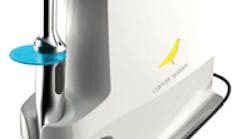by KIM MILLER, RDH, BSDH
The Canary System
Recently introduced to the U.S. dental market by Quantum Dental Technologies, the handheld Canary System uses a low-power, pulsating laser light that provides early detection of caries. Decay can be detected as deep as 5 mm and as small as 50 microns (20x smaller than a millimeter). According to the manufacturer, this safe, pain-free, noninvasive laser can detect:
- Occlusal decay
- Interproximal decay
- Root surface decay
- Decay on smooth enamel
- Decay around existing amalgam/composite fillings
- Decay under pit and fissure sealants
- Decay in between teeth at an earlier stage than the traditional dental X-ray.
According to the manufacturer, the level of contrast between health and disease is outstanding, making it easy to identify lesions in need of treatment and areas that may be remineralized. Therefore, the Canary System is ideal for tracking the results of remineralization therapy.
The system's proprietary software provides mapping of the teeth and a patient report. The report also includes the dentist's recommendations and instructions for treatment. In addition, it clearly defines for the patient which teeth are in need of remineralization therapy, which are healthy, and which have lesions that require restoration.
The "third party" laser report improves patients' understanding as they manage their oral health. Reports can be emailed, printed, or accessed from the Canary Cloud, making it easy for patients to participate in and monitor their treatment progress.
Backed by years of research (since 1999), the system has been available in Canada and Europe since 2011. It received U.S. FDA clearance in October 2012. Please visit www.thecanarysystem.com where you can see a product demo video, read testimonials and research, and request more information.
Phocal's Interproximal Fluoride Therapy
Necessity is the author of invention! This is certainly true for Dr. A. Jodaikin, Colldent's chief scientist whose awareness regarding the lack of interproximal caries prevention inspired the Phocal concept. These fluoride disks offer clinicians a simple new way to treat incipient decay.
The thin, round, semipermeable fluoride disks are designed to fit between teeth, delivering a concentrated dose of fluoride directly deposited to interproximal sites. Once placed, the disks soften and expand, forming a gel. According to the manufacturer, this action prevents dental caries on intact surfaces, arrests the progress of incipient caries, and enhances remineralization. The disks weigh 4.5 mg and contain 1.23% fluoride ions and come in two forms.
• APF-acidulated phosphate disks which:
1. Contain 0.103 mg sodium fluoride and 0.009 mg of hydrogen fluoride
2. Induce an optimized low pH environment that cleans and etches tooth surfaces
3. Facilitate deep fluoride penetration and stimulate remineralization
• pHn-nonacidic sodium fluoride disks which:
1. Contain 0.122 mg of sodium fluoride
2. Are less acidic and will not etch ceramic crowns or tooth-colored restorations
3. Induce fluoridation and remineralization
Because Phocal disks provide concentrated fluoride application to hard-to-reach interproximal areas, they can be used as an immediate therapeutic alternative to "watching" incipient decay. Phocal delivers a concentrated low but effective dosage of fluoride to the affected tooth surfaces for approximately 10 minutes before biodegrading. It creates a nanoscopic pH-sensitive fluoride reservoir, which remains active for two to three months.
Visit www.phocaltherapy.com to learn more about this innovative way to help your patients fight interproximal decay!
Colgate PreviDent 5000 Booster Plus
PreviDent 5000 Booster Plus is Colgate's most advanced formula for unsurpassed remineralization,1 making it a great choice for patients with high caries risk, crown and bridgework, or orthodontic decalcification. This prescription strength toothpaste contains 1.1% sodium fluoride with tricalcium phosphate. According to the manufacturer, PreviDent 5000 Booster Plus delivers the following benefits:
- Unique liquid gel formula, enabling faster fluoride dispersion than paste
- FloriGard Technology delivery system that produces a temporary shift in pH, resulting in 86% improvement in fluoride uptake 2
- Statistically better remineralization after 10 days and unsurpassed remineralization after 20 days when compared to ClinPro 5000 and MI Paste Plus3
- Mild cleaning with low abrasion
- Helps reverse white spot lesions4
Visit www.colgateprofessional.com to learn how PreviDent 5000 Booster Plus can help your patients. As always, contact me at [email protected]. I'd love to hear from you! RDH
References
1. Joziak et al. Comparison of enamel fluoride uptake and fluoride release from liquid and paste dentifrices. J. Dent. Res. 2003; 82 (Sp. Issue); Abs.1355.
2. Baysan A et al. Reversal of primary root caries using dentifrice containing 5,000 and 1,100 ppm fluoride. Caries Res. 2001:35:41-46.
3. Englander HR et al. JADA 75 (1967): 638-644.
4. Englander HR et al. JADA 78 (1969): 783-787.
5. Englander HR et al. JADA 83 (1971): 354-358.
KIM MILLER, RDH, BSDH, is the co-founder of PerioFrogz.com, an information-based website providing free current oral-systemic research summaries and patient education downloads. Kim is also a coach with Inspired Hygiene, delivering customized hands-on training. She speaks internationally, writes writes articles and webinars, and enjoys clinical dental hygiene. Kim lives in Arizona and welcomes you to contact her at [email protected].
Past RDH Issues








